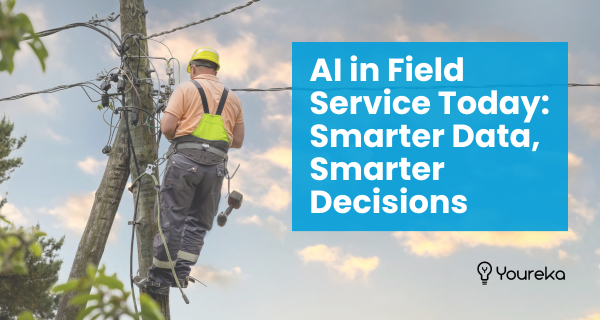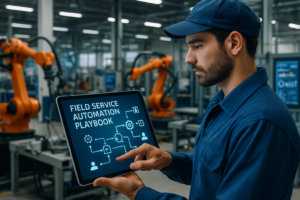
Field service teams are under more pressure than ever to work faster, reduce downtime, and capture data that drives smarter decisions. AI is already part of the solution. But in 2025, its role is shifting from automation to enablement—from simplifying tasks to powering real-time intelligence in the field.
What AI in Field Service Looks Like Today
Today’s AI tools are making life easier for field techs and service managers by automating key tasks:
- Pre-visit briefs – AI compiles work orders, asset history, and maintenance logs into summaries for technicians before they arrive on site.
- Post-visit documentation – AI writes work summaries and reports based on completed jobs, reducing paperwork.
- Predictive maintenance – AI analyzes historical failure patterns to catch issues before assets fail.
- Chat-based support – AI bots surface relevant information so techs can troubleshoot without escalating tickets.
These capabilities are valuable—but they’re not the endgame. The bigger opportunity lies in how teams collect and use field data to feed AI tools more intelligently.
AI adoption in service teams has nearly doubled since 2020. Today, 45% of service organizations are using AI—but most of it is still applied to back-end automation like case classification, summaries, or knowledge management. What’s missing is real-time, in-field intelligence that helps technicians solve problems as they work.
The Challenge: AI Needs Better Data to Drive the Next Evolution of Field Service
AI can only be as smart as the data it receives. And today, too much critical information never makes it into Salesforce—or AI models—at all.
Common challenges include:
- Disconnected data collection – Many field teams still rely on paper forms or outdated digital tools. That means gaps in reporting, lost insights, and missed automation opportunities.
- Lack of real-time support – When a technician hits a snag, they often need to call for support instead of getting suggestions from AI tools.
- Limited in-field decision-making – AI is great at summarizing completed work, but rarely guides decisions while the work is still happening.
These aren’t small issues. They impact service speed, customer satisfaction, and asset uptime—especially for large teams managing high-value infrastructure.
73% of field service teams use automation today for scheduling, dispatch, and work order management. But most are still working toward a future where AI can support in-the-moment decisions, not just automate follow-ups.
What’s Coming Next: AI That Powers Real-Time & Proactive Service
The future of AI in field service isn’t about doing the same work faster—it’s about helping teams work smarter.
Here’s where AI is headed:
- Dynamic, AI-powered forms – Forms that adjust automatically based on technician inputs, ensuring accurate, structured data capture in real time.
- AI-driven troubleshooting – Based on context from the form, work order, and asset data, AI can suggest next-best actions while the tech is still on site.
- Proactive maintenance alerts – By analyzing real-time field data, AI can flag early warning signs and prevent failures.
- Deeper AI + IoT integration – Combining IoT sensor data with smart forms and AI can trigger tasks, schedule preventive work, and surface actionable insights.
The shift is clear: AI in field service is moving from being reactive to being predictive—and from assisting with documentation to driving in-field decisions.
How Youreka Supports AI-Powered Field Service Today & Tomorrow
While most companies are still planning their next phase of AI investment, Youreka is already helping field service teams turn their data into action—inside Salesforce.
- Salesforce-native smart forms – Youreka’s forms guide techs through structured data capture inside Salesforce Field Service and Service Cloud.
- Template AI Agent – Form Template creation assisted by AI.
- Offline-ready data collection – Even without a signal, Youreka forms capture and store data, syncing automatically once reconnected.
- Better data for Agentforce – Structured field data enables stronger summaries, smarter insights, and better customer experiences—maximizing value from Agentforce.
- AI-powered Discoveries (coming soon) – Youreka’s upcoming Discoveries engine, powered by OpenAI, automatically identifies and surfaces the top 5 most critical findings from every completed form. This goes beyond structured responses:
- Form-based Discoveries flag failed safety checks, non-compliance issues, or maintenance risks based on the answers technicians provide.
- Image-based Discoveries analyze uploaded photos to detect visual risks, such as:
- “This basement shows signs of mold—and here’s why it matters.”
- “These gear teeth are worn and may lead to unexpected downtime.”
- “This electric box appears overloaded, posing a potential fire hazard.”
Youreka ensures your AI tools—like Agentforce—have the clean, contextual data they need to perform at their best.
Final Thoughts: AI in Field Service is Moving from Reactive to Proactive
AI is no longer just a way to cut down on paperwork. It’s becoming a core part of field service strategy—helping teams make better decisions, faster.
What can field service teams do today to get ready?
1. Digitize field service data collection
Paper processes limit what AI can do. Structured data is step one.
2. Invest in Salesforce-native solutions
Tools like Youreka work within Salesforce Field Service and Service Cloud—no integration headaches.
3. Plan for proactive AI
The future isn’t just about reacting faster—it’s about predicting and preventing issues altogether.
Want to see how Youreka’s smart forms power AI workflows in Salesforce? Let’s talk.
By Emmett Nolan, Gary Stom, and Conner Madigan




